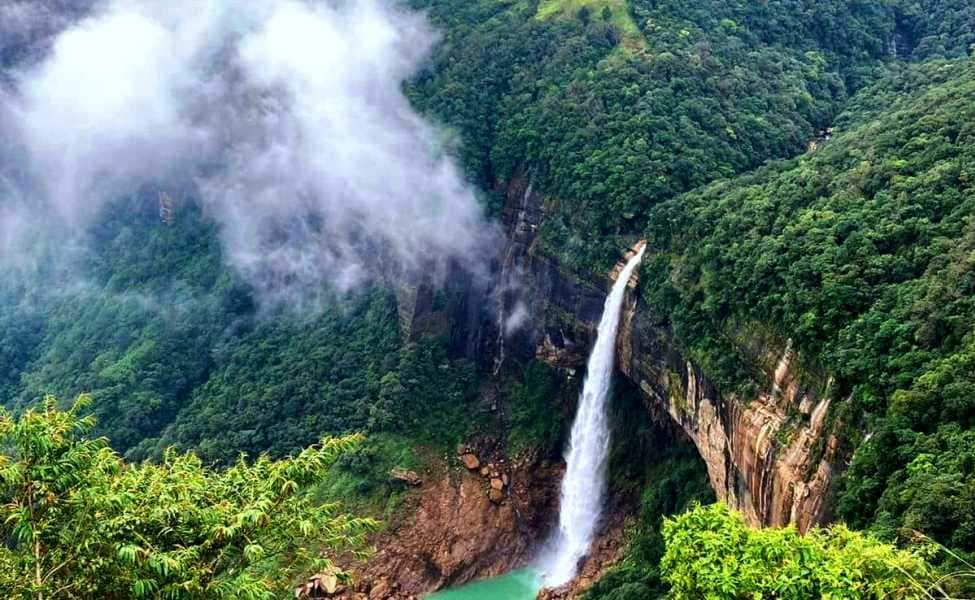
Misty, winding roads that lead to sights destined to leave you breathless and spellbound - the living root bridges that are natural architectural marvels, the vast, reverberating caves, the majestic waterfalls, and the beautiful streams and valleys. Even the best cameras cannot capture the essence of the intoxicating views and enticing beauty of Cherrapunji, Meghalaya. But the disturbing yet riveting legend that gave Nohkalikai Falls its name is what makes it the most intriguing and my favourite sight in Cherrapunji. Legend has it that Likai, a widowed young mother, stayed in a village near the waterfall. To ensure her daughter had a father figure growing up, she remarried. What was supposed to be a healthy relationship between her husband and daughter didn’t turn out that way. Jealous of the amount of love and attention Likai’s daughter was getting from her, the husband killed her and cooked a meal from her flesh when Likai was at work one day. She feasted on the meal after returning, only to find a severed finger next to her betel leaf basket, betel leaf being a customary after-meal indulgence in Meghalaya. When she realised what had happened while she was away, she ran till she plunged to her death from the falls. Noh-Ka-Likai. The name comes from this legend. When translated from Khasi, this means “The Leap of Likai”. Noh translates to “leap”, and Ka is a prefix given to women in Meghalaya. The cascading waterfall is the highest plunge waterfall in the country. With a drop of about 335 m, the Nohkalikai Falls is the fourth-highest plunge waterfall in the whole world. A plunge waterfall falls vertically without making contact with the underlying bedrock surface. Because of their forceful fall, as is the case for Nohkalikai Falls, they produce lots of water spray, making their surroundings misty. Standing atop the cliff opposite the Falls, the myriad times I’ve been there with my family, never failed to leave me spellbound. The cool breeze, the sound of gushing water plunging into a turquoise pool that transforms into a stream, the rays of sunlight beaming through the mountains and hitting the spray from the millions of water droplets from the waterfall to form the prettiest rainbow ever. Oh, how I wish the steps descending led right to the waterfall so I could have experienced all this up close because these little things, like the spray of tiny water droplets on your face, make it the mesmerising miracle it is. Did the gory, tragic story taint the beauty of one of the most scenic sights I’ve ever seen? Not one bit. If anything, it made me fall in love with the place even more. Legends are meant to make you believe in something, and this tragically beautiful one, in its own twisted way, made me believe in love and the lengths to which one can go to grieve the loss of a loved one. Cherrapunji Travels Besides Nohkalikai Falls, Cherrapunji is famous for its Double-decker Root Bridge, the Mawsmi Cave, the Seven Sisters Falls, Mawlynnong - Asia’s cleanest village, as well as Dawki - a small town on the border of India and Bangladesh. Even though they are all masterpieces of nature in their own way - some might even say they steal the limelight from Nohkalikai Falls - nothing for me can beat the feeling of standing where I stood the first time I understood how a rainbow is formed, knowing the legend behind the majestic Nohkalikai and watching it fall, disappearing into a mist.
The drive through the winding roads of Cherrapunji is probably capable of curing car sickness. And if it doesn’t, the destinations make up for it. The town is situated atop the Shillong plateau in the East Khasi Hills. This plateau averages about 1,480 metres above sea level and lies as much as 1,000 metres above the floors of the surrounding valleys. Cherrapunji itself sits at an altitude of 1,260 metres above sea level. What once was the wettest place on Earth receives a staggering 11,430 mm of rain annually.
20 Apr 2022
Aditi Krishnan